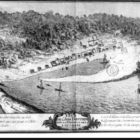French Treasure Ship Yet To Be Found
French Treasure Ship Yet To Be Found
In September 1724, a French merchant ship was located off the coast of present-day Alabama near present-day Dauphin Island. The vessel was “La Bellone.” In her hold was stored a cargo of beaver skins, deer hides, tobacco, indigo and coins and bullion valued at 40,000 crowns. She was on her way to Dauphin Island to collect the yearly production of goods by the French colonials in Louisiana, and transport them to France.
While trying to enter Pelican Bay, the Bellone ran aground. The entrance to Mobile Bay, Alabama, between Mobile Point on the western end of the Morgan Peninsula and Pelican Point on the eastern end of Dauphin Island, is an extensive natural inlet that has been improved by channel dredging activities since 1904, primarily through the outer bar at the seaward extent of the ebb-tidal delta. The ship was not damaged, however, and was soon anchored safely in the small harbor. The captain of the ship, a Seigneur de Beauchamp, kept the ship in the harbor until the next spring, when finally he decided to sail for France.
On April 1, 1725, April Fools’ Day, the Bellone raised anchor and headed out to sea on a perfectly calm day.

1725, April 2,The La Bellone sank at the first port of call, Dauphin Island at the mouth of Mobile Bay.
The entire cargo, including the bullion and coins, and all the passengers’ personal belongings, was lost with the Bellone. It was determined by French officials at the time that the ship was unsalvageable, thus no effort was exerted to recover the gold.

The Bellone was wrecked off Dauphin Island over 250 years ago. Since she sank, Dauphin Island has been partially washed away by hurricanes, Pelican Bay has been largely sanded in, and battles in the War of 1812 and the Civil War have added many other wrecks to the coastal floor.
Of all the old wrecks in and around Mobile Bay waiting to be rediscovered and salvaged, the Bellone is the richest.
In September, 1989, novelist and historian Dr. Clive Cussler attempted to find the wreck of the Bellone. His team did locate what could be the remains of the wreck but did not attempt any salvage operations.
Credit: SHIPWRECK OF “LA BELLONRE”
From Louisiana Historical Q.uarterly, Vol. 2, 11, Jan. 1919, Page 118:
Testimony ot witnesses.
The tollowing witnesses Jln’8Dlge Beauchamp, Jean Drou:l,llard, Simon Barder; Jean Choton, Jean Paul Mercier, Jean Lanot, Louis Cha- dongos, Jacques Arnould, and Nicolas Jolly concur on the tact the sinkingg ot the vessel “La Bellonne was an unavoidable disaater and probably caused by striking hard bottom or sand bars aDd snags in the river, that at dawn ot that day boats 1Illre sent ashore tpr BJ.enville and Chateauguey and their luggage. Hardly had they reached land when signals tor help were heard from La BelloDne: two Canon shots fired in quick succession followed later an interval by two others. The 1Illather was cleln’ and calm; in the sight ot all, the ship slowly sank under the water, the crew and pasengers jumping overboard with whatever they could seize for bouys. Passengers Bordier and his child 1Illre drowned also the exhausted captain ot a launch.
The wreck occurred in the harbor ot “Isle Dauphin” on April 1st, 1725.
The captain stayed on board until the last long·boat cleared.
Each deponent signs his deposition with the undersigned.
Bienville
Perry
Delaloire Flaucour
(Document taded almost to extinction.)
Lieted Louisiana Historical Q.uarterly, Vol. 2, 11, Jan. 1919, Page 118.
